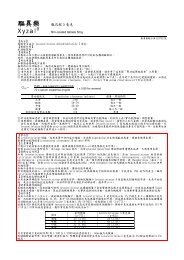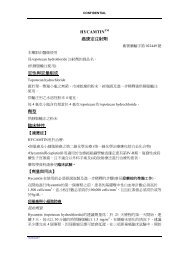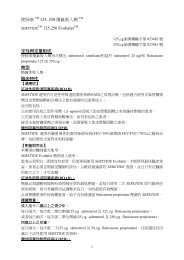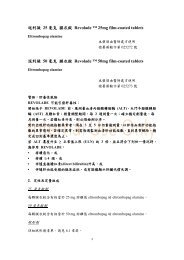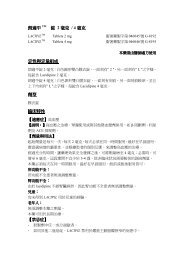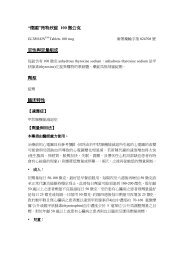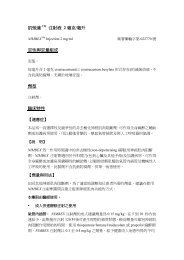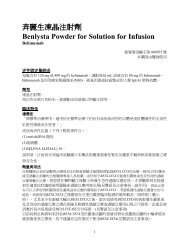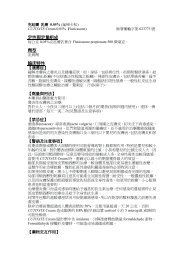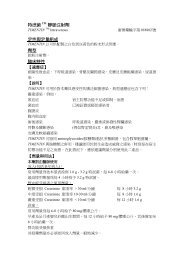RELENZA(瑞樂沙)全仿單 - 荷商葛蘭素史克
RELENZA(瑞樂沙)全仿單 - 荷商葛蘭素史克
RELENZA(瑞樂沙)全仿單 - 荷商葛蘭素史克
Create successful ePaper yourself
Turn your PDF publications into a flip-book with our unique Google optimized e-Paper software.
CONFIDENTIAL<br />
in both in vitro and in vivo activity against influenza A and B virus replication, and<br />
encompasses all of the known neuraminidase subtypes of influenza A viruses.<br />
The activity of zanamivir is extracellular. It reduces the propagation of both influenza A<br />
and B viruses by inhibiting the release of infectious influenza virions from the epithelial<br />
cells of the respiratory tract. Influenza viral replication is confined to the superficial<br />
epithelium of the respiratory tract. The efficacy of topical administration of zanamivir to<br />
this site has been confirmed in clinical studies. Clinical trial data have shown that<br />
treatment of acute influenza infections with RELENZA produces reductions in virus<br />
shedding from the respiratory tract compared to placebo without any detectable<br />
emergence of virus with reduced susceptibility to zanamivir.<br />
Pharmacokinetics<br />
Absorption<br />
Pharmacokinetic studies in humans have shown that the absolute oral bioavailability of<br />
the drug is low (mean 2%). Similar studies of orally inhaled zanamivir indicate that<br />
approximately 10 to 20% of the dose is systemically absorbed, with serum concentrations<br />
generally peaking within 1-2 hours. The poor absorption of the drug results in low<br />
systemic concentrations and therefore there is no significant systemic exposure to<br />
zanamivir after oral inhalation. There is no evidence of modification in the kinetics after<br />
repeated dosing with oral inhaled administration.<br />
Distribution<br />
After oral inhalation, zanamivir is widely deposited at high concentrations throughout the<br />
respiratory tract, thus delivering the drug to the site of influenza infection. Following a<br />
single 10 mg dose the concentrations of zanamivir were measured at the epithelial layer<br />
of the airways, the major sites of influenza viral replication. Zanamivir concentrations of<br />
approximately 340 and 52 fold above the median viral neuraminidase IC 50 were<br />
measured at 12h and 24h, respectively. The high concentrations of zanamivir in the<br />
respiratory tract will result in the rapid onset of inhibition of the viral neuraminidase. The<br />
two major sites of deposition are the oropharynx and the lungs (mean 77.6% and 13.2%,<br />
respectively).<br />
Metabolism<br />
Zanamivir has been shown to be renally excreted as unchanged drug, and does not<br />
undergo metabolism.<br />
Elimination<br />
The serum half-life of zanamivir following administration by oral inhalation ranges from<br />
2.6 to 5.05 hours. It is entirely excreted unchanged in the urine. Total clearance ranges<br />
from 2.5 to 10.9 l/h as approximated by urinary clearance. Renal elimination is<br />
completed within 24 hours.




